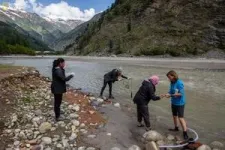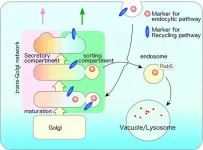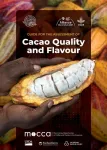(Press-News.org) Significant quantities of microplastic particles are being trapped in riverbed sediments or carried through the air along major river systems, a new study has shown.
The research, conducted along the length of the Ganges River in South Asia, found on average about 41 microplastic particles per square metre per day settled from the atmosphere. .
In addition, analysis by scientists found 57 particles per kilogram on average in sediment from the riverbed as well as one particle in every 20 litres of water.
The research, published in Science of the Total Environment, represents the first combined analysis of microplastics in water, sediment and air around a major river system.
It was conducted using samples collected by an international team of scientists as part of the National Geographic Society's Sea to Source: Ganges expedition.
Lead author Dr Imogen Napper, a Research Fellow at the University of Plymouth and National Geographic Explorer, said: “We have known for some time that rivers are key pathways for the transfer of microplastics to marine environments. However, there has always been uncertainty about the sheer amounts being transported, and whether they represent long-term sinks. This study goes some way to unravelling that mystery, and revealing the true scale of microplastic contamination that our river systems can represent.”
The research involved scientists from: the University of Plymouth (UK); the Wildlife Institute of India (India); the University of Dhaka, WildTeam, and Isabella Foundation (Bangladesh); National Geographic Society, University of Georgia (USA); ZSL (Zoological Society of London), University of Exeter (UK); and Nantes Université (France).
Many of the same scientists were involved in a previous study, published in January 2021, which suggested the Ganges River and its tributaries could be responsible for up to 3 billion microplastic particles entering the Bay of Bengal every day.
In addition to highlighting the overall abundance of particles, for the new study scientists found fibres to be the most common type, representing up to 99% of the microplastics discovered in some of the samples analysed.
Within this, rayon (synthetically altered cellulose) was the dominant polymer – representing up to 82% of the fibres found in some samples – ahead of acrylic and polyester, and blue was the most common colour.
The sediment samples often contained denser microplastic particles than those found in water and air, and higher population densities correlated with increased microplastic abundance for air and water samples.
Writing in the study, scientists say they believe clothing is likely to be the prominent source of microplastics to this particular river system, influenced by atmospheric deposition, wastewater, and direct inputs such as the handwashing of clothes in the Ganges.
Dr Anju Baroth, scientist and PI from Wildlife Institute of India, said: “Earlier studies based on modelling had reported rivers in Asia as one the largest source of microplastic pollution to sea. This research based on primary field data has provided clear insight on the levels of microplastics in different environmental matrices of river Ganges and that several major river systems of the world have reported comparatively higher microplastics than the Ganges. This study could be used to further mature the theory on major sinks and sources of microplastics in major river systems of the world.”
Dr Gawsia Wahidunnessa Chowdhury, country lead in Bangladesh, added: “This research is ground breaking and we need to make the findings understandable for the key stakeholders. including policy makers. This research provides a platform for global scientists and we have developed a collaborative research group who have been working hard to implement innovative solutions locally for Bangladesh.”
Professor Heather Koldewey, ZSL (Zoological Society of London) Senior Marine Technical Advisor, said: “Our research shows that clothing is the major source of microplastics in the air, water and sediment of this vast river system, enabling us to work with partners and policy makers to seek locally appropriate solutions. These can be informed and supported by the brilliant scientists from Bangladesh and India who were key members of the team involved in this paper.”
END
Rivers contain hidden sinks and sources of microplastics
Research carried out along the Ganges River passing through India and Bangladesh represents the first combined analysis of microplastics in water, sediment and air around a major river system
2023-09-25
ELSE PRESS RELEASES FROM THIS DATE:
By air, rain and land: How microbes return after a wildfire
2023-09-25
Highlights:
Ecological disturbances like wildfires disrupt microbial communities.
Researchers studied microbial succession for a year in a field, following a fire.
They found that dispersal played a pivotal role in re-establishing surface-level communities.
Dispersal from wind or rain explained the return of most fungal species. Bacterial communities were influenced by both air and deeper bulk soil.
Washington, D.C. — The disruption brought by wildfires reaches everything that lives in or near a burning field or forest—including microbes. A better understanding ...
Companies may benefit from transparency about racial diversity efforts
2023-09-25
WASHINGTON – Companies that reveal their struggles to increase racial diversity in their workforces are perceived as more trustworthy and committed to diversity than companies that remain silent, according to research published by the American Psychological Association.
“We suspect that many companies fear that revealing lagging diversity numbers will undermine their reputation and credibility, so they don’t disclose that information, but that strategy may be misplaced,” said lead researcher Evan ...
Social impact entrepreneurs: Funding available for local health equity solutions in Houston
2023-09-25
HOUSTON, September 25, 2023 – In Houston, people who live south of downtown in the Sunnyside neighborhood can expect to live an average of 21 years less than those who live just nine miles away in the more affluent Bellaire community[1]. This life expectancy gap is nearly equivalent to the difference in life expectancy between low-income and high-income countries. The science tells us that physical conditions in which people live explain in part why some are healthier than others[2].
To sustainably remove the social and economic barriers preventing access to equitable health for everyone ...
New study sheds light on the impact of in-stream video advertising on ad information encoding
2023-09-25
The effects of in-stream video advertising on ad information encoding have long remained a mystery. A recent study, led by Professor Sung-Phil Kim and his research team in the Department of Biomedical Engineering at UNIST sheds light on this subject. By integrating the negative emotion–memory model (NEMM) and the limited capacity model of motivated–mediated message processing (LC4MP), researchers investigated how advertising content is encoded within the context of in-stream video advertising.
The ...
Political independents are more negative than partisans
2023-09-25
COLUMBUS, Ohio – In this era of extreme partisanship, the people who express the most negativity in their political choices are those we may least expect: independents.
In a new paper, researchers conducted five studies in which they found that independents were more likely than partisans to frame their position in terms of opposition to one party, candidate, message or option rather than in support of the other choice.
And it’s not just in politics: One study found that “independents” ...
Loma Linda University researchers find contaminated water in fast-food soda fountains
2023-09-25
Loma Linda University (LLU) researchers found microbial contamination in common sources of drinking water in the Eastern Coachella Valley, including soda fountains at fast-food restaurants. Their findings revealed that 41% of the water samples researchers collected from these soda fountains contained total coliforms, an indicator of water contamination.
Molecular analysis of the water samples revealed traces of genetic material found in bacteria, including Salmonella spp (Salmonella), Pseudomonas aeruginosa, and Escherichia coli (E. coli). Given these findings, ...
Uncovering novel mechanisms of endocytosis and intracellular trafficking
2023-09-25
Endocytosis is an important cellular process through which cells internalize substances such as water and nutrients. These substances are first transported as cargo to the initial sorting compartment (endosomes) before being degraded (endo-lysosomal pathway) or recycled (recycling pathway of the plasma membrane). The trans-Golgi network (TGN), which lies adjacent to the Golgi apparatus, is a key mediator of this intracellular transport. Endocytosis mediates the infection of harmful pathogens such as bacteria and virus, and its disruption may lead to several diseases. It is, ...
Transforming the cacao sector: introducing the guide for the assessment of cacao quality and flavor
2023-09-25
[Rome, 25 September] - The cacao sector has long grappled with challenges stemming from the absence of commonly agreed standardised protocols for evaluating cacao quality and flavour, as well as the lack of a common language to describe the sensory experience of cacao. These issues have impeded effective communication and understanding between producers and buyers, disproportionately affecting farmers in developing countries who strive to cultivate and sell superior quality cacao deserving of higher prices.
Today, Cacao of Excellence is proud to unveil a groundbreaking initiative aimed at addressing these long-standing issues — the Guide for the Assessment of Cacao Quality and Flavour. ...
Genetic code of rare kidney cancer cracked
2023-09-25
GENETIC CODE OF RARE KIDNEY CANCER CRACKED
The genetic code of a rare form of kidney cancer, called reninoma, has been studied for the first time. In the new paper, published today (25th September) in Nature Communications, researchers at the Wellcome Sanger Institute, Great Ormond Street Hospital and The Royal Free Hospital also revealed a new drug target that could serve as an alternative treatment if surgery is not recommended.
There are around 100 cases of reninoma reported to date worldwide (1), and it is amongst the rarest of tumours in humans. Although it can usually be cured with surgery, ...
Waterfleas hold key to cleaner environment and better human health
2023-09-25
Tiny waterfleas could play a pivotal role in removing persistent chemical pollutants from wastewater – making it safe to use in factories, farms and homes, a new study reveals.
Rapid urbanisation, population growth, unsustainable food production and climate change have put unprecedented pressure on water resources, culminating in a global water crisis. The sustainable management and reuse of water resources is paramount for ensuring societal, economic, and environmental well-being.
Persistent chemical pollutants, originating from domestic and industrial processes, ...
LAST 30 PRESS RELEASES:
Why nail-biting, procrastination and other self-sabotaging behaviors are rooted in survival instincts
Regional variations in mechanical properties of porcine leptomeninges
Artificial empathy in therapy and healthcare: advancements in interpersonal interaction technologies
Why some brains switch gears more efficiently than others
UVA’s Jundong Li wins ICDM’S 2025 Tao Li Award for data mining, machine learning
UVA’s low-power, high-performance computer power player Mircea Stan earns National Academy of Inventors fellowship
Not playing by the rules: USU researcher explores filamentous algae dynamics in rivers
Do our body clocks influence our risk of dementia?
Anthropologists offer new evidence of bipedalism in long-debated fossil discovery
Safer receipt paper from wood
Dosage-sensitive genes suggest no whole-genome duplications in ancestral angiosperm
First ancient human herpesvirus genomes document their deep history with humans
Why Some Bacteria Survive Antibiotics and How to Stop Them - New study reveals that bacteria can survive antibiotic treatment through two fundamentally different “shutdown modes”
UCLA study links scar healing to dangerous placenta condition
CHANGE-seq-BE finds off-target changes in the genome from base editors
The Journal of Nuclear Medicine Ahead-of-Print Tip Sheet: January 2, 2026
Delayed or absent first dose of measles, mumps, and rubella vaccination
Trends in US preterm birth rates by household income and race and ethnicity
Study identifies potential biomarker linked to progression and brain inflammation in multiple sclerosis
Many mothers in Norway do not show up for postnatal check-ups
Researchers want to find out why quick clay is so unstable
Superradiant spins show teamwork at the quantum scale
Cleveland Clinic Research links tumor bacteria to immunotherapy resistance in head and neck cancer
First Editorial of 2026: Resisting AI slop
Joint ground- and space-based observations reveal Saturn-mass rogue planet
Inheritable genetic variant offers protection against blood cancer risk and progression
Pigs settled Pacific islands alongside early human voyagers
A Coral reef’s daily pulse reshapes microbes in surrounding waters
EAST Tokamak experiments exceed plasma density limit, offering new approach to fusion ignition
Groundbreaking discovery reveals Africa’s oldest cremation pyre and complex ritual practices
[Press-News.org] Rivers contain hidden sinks and sources of microplasticsResearch carried out along the Ganges River passing through India and Bangladesh represents the first combined analysis of microplastics in water, sediment and air around a major river system






